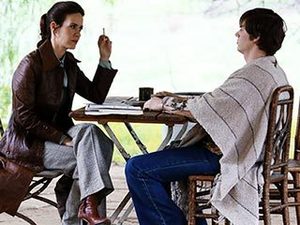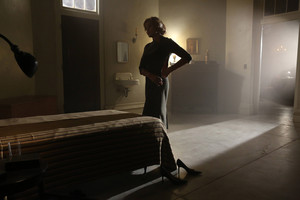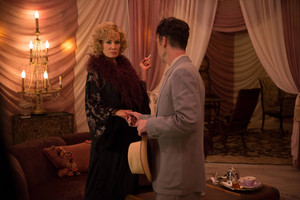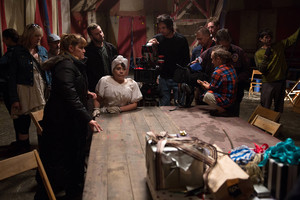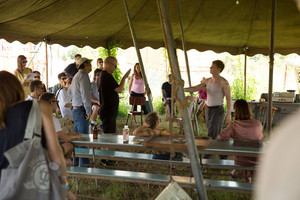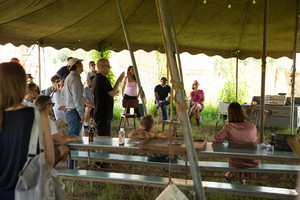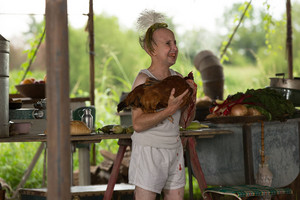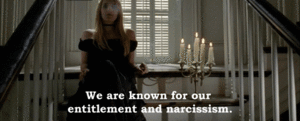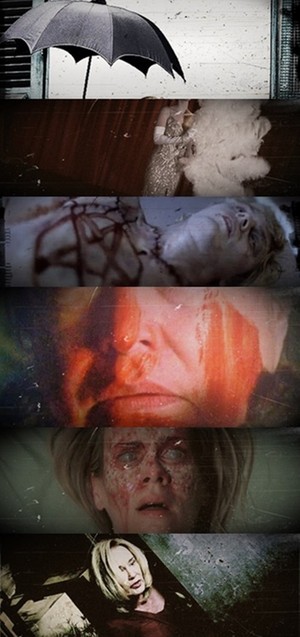Episode 13 | Aired Jan 23, 2013
An interview with Lance... er, Lana Winters leads to confessions, revelations, and one thêm battle with Bloody Face in 'Madness Ends'
bởi Jeff Jensen at EW
For the một giây time this season, American Horror Story: Asylum unintentionally tapped the zeitgeist in a way only super-psychic Billie Dean Howard could have foreseen. On Halloween, we watched a “Nor’Easter” lash Briarcliff Manor Sanatorium during a black mass movie night as Hurricane Sandy completed its terrifying week-long rampage up and down the East coast. Last night, less than a week after Lance Armstrong spilled his guts (or tried to) with Oprah Winfrey about doping his blood to achieve đạp xe, chạy xe đạp greatness, we watched a seventy-something superstar journalist Lana Winters look back on her eventful life during an epic TV interview and “come clean” about the lies and massaged facts that shaped her lucrative, illustrious brand. But was confession her intention all along? hoặc was she influenced bởi the unexpected presence of her most shameful secret, Johnny Morgan, the rape-seeded son of Bloody Face? At what point during the sit-down did she come to the chilling realization that once the cameras stopped rolling, she’d once again have to fight for her survival against another mad and monstrous Thredson?
It all made for a spectacular climax to a spectacular season, one that slammed trang chủ with head-spinning, heart-rending hurricane force its epic yarn about the lunatic legacy of corrupt ambition and unchecked injustice. It also affirmed the powerful potential of American Horror Story’s anthology format. Special commendations to writer Tim Minear and director Alfonso Gomez-Rejon for some bravura storytelling. It was wicked smart and unabashedly show-offy and I loved every crazy-angled, vertiginously shot, time toggling, stories-within-stories-within stories một phút of it. Holding the center of this yarn-spinning storm were remarkable performances bởi Sarah Paulson and Jessica Lange. But what was most meaningful about the finale was its biggest surprise: An emphasis on redemption – well earned and unsentimental – that helped to produce a moving, emotionally resonant experience.
The time: Now. Lana Winters in her twilight years was still one tough (don’t-call-me-a) cookie, thanks in some small part to plastic surgeon in Paris and a talented dermatologist who kept her well preserved. Okay, she looked a little frail with that shuffle and slight hunch, but ngọn lửa, chữa cháy still burned in her eyes. She had love, if not marriage, with a vibrant woman, a celebrated opera singer named Marion. The crimson carpeted parlor of her deluxe apartment was adorned with awards and mementos of a career spent profiling the world’s most powerful people, world leaders and celebrities, most of them men. (I loved the inspired touch of Bono’s framed cốc-tai, cocktail napkin doodle, drawn for Lana while she shadowed him on one of his humanitarian globetrots -- an allusion to either the U2’s singer’s work on behalf of The ONE Campaign hoặc Jubilee 2000. thêm on the possible thematic significance, later.) She was about to add one thêm medal to her chest -- a Kennedy Center Honor – and this alterna-world Barbara Walters agreed to turn the tables on herself and give a TV interview to mark the occasion. I loved the moment when the dope hiển thị pro coached the crew on how to hang the lights and make “an old gal” look gorgeous. “Higher, babe. Atta, boy. No, higher still,” đã đưa ý kiến Lana with a croak she owed to cigarettes and bourbon. “What are they teaching these kids in film school?”
A brief backtrack for some context. When we last saw Lana, the năm was 1969, and she had just rocketed to fame as the best-selling tác giả of Maniac: One Woman’s Story of Survival and was planning to write even thêm True Crime sách about thêm sick psychos like Lee Emerson. “The stunted male psyche,” she told Kit Walker, was her great subject. She was no longer interested in taking down Briarcliff, as she had promised, hoặc becoming a do-gooder investigative reporter. Defeated bởi so much profound loss, the Asylum survivor wanted assured success at what she did and she wanted to profit from it, and she knew she could make it rain with so much Helter Skelter and In Cold Blood. Lana Winters, it seemed, had sold out…
But she didn’t. Not totally. Perhaps Kit had gotten under her skin. Perhaps she had momentarily allowed sudden, newfound prosperity -- well-earned and profoundly needed – go to her head and stun her with cynicism. Regardless, Lana decided to take a different path. For starters, she became do-gooding investigative journalist, after all, specializing in take-downs of corrupt institutions and naughty overgrown boys. She began bởi settling some old scores. First, there was Briarcliff (more on this in a minute). Then, she exposed the sins of Dr. Arthur Arden and Cardinal Timothy Howard – a pitiless skewering that drove the latter to slit his wrists. (“Happy Easter!” to bạn too, asshole!) In thêm gần đây times, Lana made headlines with a “nail-him-to-the-cross” prison interview with Ponzi Scheme king Bernard Madoff. (The interviews that got away: Mao; Rielle Hunter, John Edwards’ mistress; and WikiLeaks founder Julian Assange, although she’s still trying to bag him.) But she did all of this as a broadcast journalist: Despite the six best-sellers (including Maniac and Tales of Briarcliff, also available as a Book On Tape, read bởi the author, no less), the McLuhan-era product come to believe that hình ảnh were thêm powerful than words, and that electronic media was the medium that could massage the most change in the global village. (When Lana told April, her Kennedy Center interviewer, that “my future wasn’t in print,” I recalled the last episode, when we learned she had stretched the truth in her book, and her conscience wouldn't let her forget it. I wondered if she gave up nghề viết văn because she found it too easy, too tempting to confabulate in this medium, especially được trao her penchant for ripe, purpled prose (not that there’s anything wrong with that!), whereas visual storytelling kept her honest -- “the camera doesn’t lie” and all that (even though it can) – and living honestly mattered to her. thêm on this as we go.)
Lana had also được trao up profiling psychos, too. She came to realize that lavishing those damnable jokers with attention came at a cultural price: It turned them into icons, and to some warped minds, even heroes. (See: The Bloody Face Fanboys who murdered “horror freaks” Teresa and Leo in “Nor’Easter;” also see: the Followers of Franklin from season 1, “Home Invasion.”) Hence, Lana told April that she wouldn’t talk about Bloody Face. But it’s what made bạn famous! “My point exactly. He’s become a goddam household name, like some Heath Ledger Hollywood movie ngôi sao villain!” thundered Lana. “He was an evil monster who used murder and torture to keep himself feeling like a eunuch. End of story. I refuse to give him one thêm một giây of attention.”
Lana’s regret about building her brand bởi turning Bloody Face into an American Idol spoke to one her most redeeming qualities, self-awareness. It allowed her to recognize other flaws in her character, too. And so, as April turned the interview toward Lana’s reputation as a “crusader for change,” the living legend continued to make some corrections to the record. “That’s the myth: ‘Lana Winters, Crusader.’ It’s a myth I helped to perpetuate. But it’s time I come clean,” she said. “It wasn’t justice that got me back to Briarcliff. It was ambition.” She wasn't driven to save the unfortunates languishing in The Asylum. She wanted to exploit them for their “stimulating” visual power. “And believe me, there is nothing thêm stimulating than crazy people. But thêm than that, bạn need an angle. A hook. And boy, did I have a doozy.”
A flashback took us behind the scenes of “Briarcliff Exposed!” and revealed the self-serving spectacle Lana wanted to produce. We watched Lana pluck her eyebrows and prepare her face, then sneak a two-man crew into The Asylum via the death chute, the same passageway she used to infiltrate Briarcliff back in 1964. The conditions within the sanatorium had deteriorated alarmingly since The State took over from The Church back in ‘66. So much filth. So much decay. So many barely-clad inmates shivering and convulsing in the darkness and forcing their feces on each other. It was slightly over the top, but affecting, nonetheless. Lana stayed focused and coldly composed. When an orderly discovered them, Lana didn’t turn tail and run. She put a microphone to his face and made him answer for the human catastrophe. “I’m sorry,” he said, looking both busted and too worn down to lie. “There’s just too many for us to take care of.”
The Briarcliff horror show: Caught on tape at last! But this wasn’t the tale Lana wanted to tell. This wasn’t her “doozy hook.” What she wanted was the story of a rescue mission, starring herself as the hero, making good on her ‘I shall return!’ vow to Judy Martin. We saw the scene Lana wanted to capture: Lana locating Judy’s cell, throwing her arms around her former tormentor and jailer, declaring the old nun liberated from the abused heaped upon her bởi Science and Church, and guiding the now-mad horror hag out of the darkness and into the light like Jesus leading Lazarus out of the tomb. Judy would affectionately call her savior bởi her pet name – “Lana Banana” – and the viewing audience would wipe away tears and smile.
Alas, Lana couldn’t get any of that on film, because none of it happened. Judy’s cell was as empty. The woman was nowhere to be found. “Briarcliff Exposed!” was a cultural sensation nonetheless – shades of Geraldo Rivera’s career-making reports on Willowbrook State School in New York – but for Lana, the hiển thị was as disappointing as The Mystery of Al Capone’s Vaults. Yes, she shuttered Briarcliff, and that was “one hell of an ending. It just wasn’t the ending I wanted.”
Lana asked to take a break to freshen up. A member of the crew brought her some mineral water. She looked up and saw the face of Johnny Morgan. We would later learn that she knew exactly who he was. But did she know he'd been there the entire time? hoặc was this an unsettling epiphany? Either way, Lana kept cool. “Thanks,” she said, taking the bottle. “You're a doll.”
The interview resumed, and took us into the most moving section of “Madness Ends,” and straight into the surprising tim, trái tim of American Horror Story: Asylum. Lana didn’t give up on her quest to produce a made-for-TV reunion with Judy. While examining a mess of paperwork that one of the Briarcliff inmates had been using for bedding, Lana found the file for Betty vịt đực, drake – the identity Monsignor Timothy created for Judy to keep her hidden within the sanatorium. She learned that Betty had been discharged on March 27, 1970 into the care on one Kit Walker. To the Walker farm, then, where Lana's Asylum soul brother warmly greeted her like a prodigal sibling and saluted her for closing Briarcliff as she promised. But Kit turned cold when he saw Lana’s crew rolling film on their intimate moment. Lana wanted to know about “Betty Drake.” Kit agreed to tell her privately. No cameras. Lana called cut. She wasn’t going to get an interview she could put on TV…
But Lana did get a story that changed her life.
Kit explained that after Lana refused to keep her promise to liberate The Asylum, he felt he had to do something. He couldn’t raze the joint. He couldn’t play Moses and lead the unfortunates out of captivity. But what he could do was be a friend to Judy Martin, the most friendless person he knew.
He began visiting her in the common room. They played checkers. They talked, but rarely about the future, and never about the past. Kit lavished her with presence, and the attentiveness produced a change in Judy: Her dead eyes began to spark with life. Now and then, a smile.
And then Kit did something radical. Something that seemed unimaginable many episodes ago, when Sister Jude was caning his đít, mông, ass raw, threatening him and Grace with castration, and burning Lana’s brain with ECT. Kit took Judy home, to live with him and his two kids, Thomas and Julia. Lana was baffled. Why turn the other cheek? What up with the 'love thy enemy' stuff? Kit đã đưa ý kiến it was all about clearing out the psychic scar tissue of past trauma so he could be thêm wholly present, in the present, with his children. “I didn’t do it for her. I didn’t even really do it for me. I did it for the kids,” he said. “I needed to be there for them. And the only way I could leave Briarcliff behind once and for all was to find some way to forgive, to find someone to forgive.”
Kit made his relationship with Judy sound like a means to a selfish end. But if that was true, things changed. As Kit and his kids invested in Judy, she became thêm important to them, and in turn, she was able to give back to them. This transformation didn’t come easy. Judy had to be weaned off The Asylum meds that kept her dopey and dim. The detox was arduous. Once Judy was purged of poison, the Walkers nursed her back to health with the organic yield of their farm, and more. A sweet moment: Julia putting hoa in Judy’s hair, making her pretty, making her feel pretty. Kit beamed with pride. Judy just beamed. She was coming back to life…
“But it got worse before it got better,” đã đưa ý kiến Kit. Judy’s mind, her frazzled, fragmented mind, was a problem that seemed beyond the resources of the Walker family. Sometimes, she’d be able to play with the kids and help around the house. Other times, madness reigned. It came to a head to one (slightly comical) ngày when Judy – thinking she was Sister Jude; believing she was still running The Asylum – chased Thomas around the house with a broom, threatening to cane him for some petty disobedience. Kit stopped her and tried to tame her with reason, but Judy was cruising for a complete and total mental breakdown…
Until the children – Kit’s inexplicable, maybe magical progeny, whose fetal development had been enhanced bởi extraterrestrial prenatal care -- intervened. Thomas and Julia took the dispirited, depleted Judy bởi the hand, led her into the field, and into the mist-bound forest beyond, and drowned her in cún yêu, con chó con Lake before burying her in Pet Sematary. “I still don't’ know what happened in those woods,” Kit told Lana. “When they came back, something was different.” Meaning: Judy had been miraculously healed. “Grace was right,” đã đưa ý kiến Kit of the wife who believed that the aliens were a harbinger-facilitator of humanity’s spiritual evolution, a la the Monoliths of 2001: A không gian Odyssey. “Those kids are special.”
For the tiếp theo six months, the Walker house was electric with tình yêu and vitality, most of it generated bởi the revived Judy Martin. She returned the kindness done to her bởi investing in Kit’s kids. She gave them all she had, which included wisdom culled from hardships survived, mistakes made, and sins committed. “She taught them how to lung lay, swing dance and swear like sailor. Made Thomas learn to sew. Took away Julia’s búp bê and gave her trucks so she’d grow up tough,” đã đưa ý kiến Kit with a laugh. Judy’s parenting strategies may not have been completely sound, but Kit appreciated them, nonetheless. It was all poignant, and yes, quite sentimental. So I liked how Kit (and the show) declined to make any kind of grand philosophical hoặc religious statement with this stuff, hoặc let Judy off the hook for the legacy of her actions. “I don't know if those last six months made up for a lifetime of horror. But she sure seemed happy,” đã đưa ý kiến Kit with a big smile. In an episode that alluded to Bono’s humanitarian work, Kit’s handling of Judy reminded of the Biblical underpinning of Jubilee 2000: The cancelation of debts; freedom from slavery; restoration to an original state of ownership. In an episode that took a swipe at The Joker, I was reminded of how Kit’s model of heroism runs completely counter to the fashionable archetype embodied bởi Batman, a vigilante driven bởi anger and vengeance. Kit could have left “Betty Drake” to rot in The Asylum. Instead, Kit worked her like the farmer he was. He sewed hard, tough ground with forgiveness, fertilized with sacrifice and love, and cultivated a change that was rich with fruit. The yield had nourished his family, and he rejoiced. hoặc something like that.
Anyway, it all moved me to tears.
One day, while teaching Kit and the kids a new lung lay, swing step to “Jump Jive And Wail,” Judy’s nose began to bleed, her knees went weak, and that was that: Judy’s mysteriously blessed bonus period of fully realized living was over. Thomas and Julia cuddled with her as she gave them final instructions. To Julia: “Don’t bạn ever, ever let a man tell bạn who bạn are hoặc make bạn feel like bạn are less than him. It’s 1971, and bạn can do anything bạn want. Okay?” To Thomas: “Don’t pick your nose.” (Pause for a sobby guffaw.) “And never take a job just for the money. Find something that bạn love. Do something important.” (If only someone had được trao the aforementioned Mr. Madoff such Lời khuyên when he was a kid.) Kit arrived with thực phẩm and herbal balms, but Judy waved them off. It was time to go. The kids wanted to stay with their “Nana” – Judy must have loved hearing them call her that – but she backed Kit’s request that they leave the room.
“I’m not going anywhere,” đã đưa ý kiến Kit. “I’m not leaving bạn alone.”
“I’m not alone,” đã đưa ý kiến Judy. “She’s here for me.”
Judy was referring to the woman in the room that Kit could not see, the femme fatale Angel of death. “Jude, we’ve been doing this dance for so many years now,” đã đưa ý kiến Shachath. “Are bạn sure you’re ready this time?”
“I’m sure. I’m ready now,” đã đưa ý kiến Jude as the reality of farm faded away into blackness, leaving only her and the Angel to complete a timeless transaction. “Kiss me.”
The đàn piano tinkled. The black wings spread. Shachath bent low to give her transporting kiss, and Judy Martin passed away.
It was a happier ending than Judy could have ever hoped for. And it’s not an ending that would have happened if Lana Winters had gotten her way. Would this Barbara Walters copycat have worked to rehabilitate Sister Jude’s life after exhausting her ratings value? Probably not.
But no one was thêm grateful for Judy's turn than Lana herself. Kit’s extraordinary work enriched her life, too. They rekindled their friendship. She became godmother to Kit’s kids, allowing her the chance to experience parenthood (or at least a semblance of it) at a time when gay women “were resigned to not having children.” She helped the children grow into dynamic adults now plotting the alien takeover of the planet. Julia was a neurosurgeon at John Hopkins University. Thomas was a law professor at Harvard.
Lana was also there at Kit’s wedding to the last great tình yêu of his life, Allison. And Lana did everything she could to make sure that Kit was comfortable as possible during the last months of his life. Of course, everyone who knew Kit wanted to attend to him when they learned he had terminal cancer. “But he wouldn’t hear of it,” Lana recalled to April. And so it went that there were no witnesses to his final fate: One day, while dozing in his wheelchair, Kit was roused to consciousness bởi a familiar roar and white hot light, and as his eyed popped wide, we saw the aliens with their strangelove fingers float-crawling toward him to claim him – to reward him, I believe, for a life well lived. And with that: Energize. Kit beamed up. tiếp theo stop: The final frontier. “No one could explain what happened. No note. No tracks. No clues. And no need for a funeral,” đã đưa ý kiến Lana. “The kids insisted there was no need for one.”
In the end, American Horror Story offered no concrete explanation for the aliens. (A New Age analog to the Judeo-Christian Shachath, maybe?) While some những người hâm mộ might be frustrated about this, I am not. I think it’s for the best that ETs remain open to interpretation. They offered great metaphorical value, and any attempt to pin them down with specifics would probably render them silly and sap their thematic power. A final thought on this storyline: Asylum in many ways was about the legacy of the sixties, and a midcentury idealistic humanism represented bởi The Civil Rights Movement, The Beats, hoa Power and "All bạn Need Is Love" rock that promised and portended great social change, however painful and tumultuous. (The Carole King song that took Lana to Kit Walker's door: I feel the Earth over under my feet/I feel the sky tumbling down) It was a close encounter with a future that electrified some (think: Grace) and terrified others (think: Alma), and the spirit of that time was captured in the iconic, enduring sci-fi of era: 2001: A không gian Odyssey, about man’s frightening, transforming engagements with strange and sophisticated and superior ideas/technology/Others (depending on your POV); and, of course, ngôi sao Trek, Gene Roddenberry’s long-lived a vision of optimistic, progressive, global village futurism. In its uniquely angry and baroque way, American Horror Story: Asylum was all about expressing a wish. Not for nothing the Stevie Wonder song that “Madness Ends” chose to play over the footage of Kit’s funky-trippy hippy-happy wedding: I wish those days would comes back once more/Why did those days ever have to go?/Cause I tình yêu them so…
Yeah, I’m corny like that.
The sự nhướng, nâng lên of “Madness Ends” took a tonal turn once the story began to veer toward its endgame, and a darker, thêm ironic take on the individual’s responsibility to redeeming the culture: Lana’s showdown with the embodiment of Bloody Face’s demented, deadly legacy, Johnny Morgan.
Lana set the stage for the conflict with her most shocking disclosure to the Kennedy Center interview team. In her book, Maniac, Lana claimed that Oliver Thredson’s baby boy died shortly after she gave birth to him. But this wasn’t true, she said. After that hideous single nursing seen in “Spilt Milk,” Lana gave the infant back to the nurse. “Don’t ask me to do that again. He’ll have to learn to live without me.” It was the last time she ever saw him… until years later, when Lana used her skills as a sleuth (“which, we know, are myriad” – loved that) to check up on the boy during a period of her life when she felt wracked with guilt for giving him up. (The Kit Walker influence, perhaps?) She found her unwanted offspring – a dead ringer for Thredson – as he was being beaten and bullied bởi a brutish thug. Lana Winters, Crusader, to the rescue: “HEY bạn LITTLE SHIT! Back off before I hurt bạn in ways bạn never dreamed of!” The bully skulked away, leaving Lana and Johnny to a moment as awkward as it was charged. What was there to stay? “You know he’s the asshole, right?” asked Lana. Johnny – thêm embarrassed than grateful for the Good Samaritan save – said, “Yeah, I know!” and scooted away.
“It was the last time I saw him,” Lana told April. “I wasn’t his mother. But I thought about him so often, wondering where he was, and how he turned out.”
After the interview, Lana showed April and her camera crew to the door. She should have gotten ready to tham gia Marion for “that Sondheim thing.” Instead, she walked to the bar and pulled out two glasses. “Can I pour bạn a drink?” she said. “Why don't bạn come out now? No need to hide. Not anymore.”
Johnny Morgan, skanky and scruffy, revealed himself. Smirky-triumphant. Looking as smug as Lana did when she ambushed Oliver Thredson in his apartment decades earlier during their final confrontation.
“Let's get this over with, shall we?” asked Lana.
They sat down. They drank. Burning các câu hỏi were asked and answered. Lana: How did Johnny get on the crew? Simple. He learned about the interview from Lana's gabby doorman, then killed the first guy to arrive – the donut dude – and took his place. (Again: Like mother, like son. Lana worked a pastry angle to get to Sister Jude back in '64: She pretended she was interested in The Asylum's bakery biz.) Johnny: How did Lana recognize him? “Oh, Johnny,” she purred. “How could I not recognize my own baby boy?”
But this was a lie. In a quick flashback, we saw that a week earlier, detectives visited Lana and told her all about Johnny Morgan, and how he had killed five people. Among them: an elderly couple who owned the trang chủ where Thredson had raped and tortured Lana back in ’64, where she had shot and killed him with a bullet to the head in ‘65. Lana looked at the bức ảnh the adult Johnny and said, “I’ve never seen him before in my life.”
(I don’t know about you, but I gave brief consideration to the possibility that Lana made up that story about feeling guilty about giving up Johnny, about seeking him out when he was a boy and saving him from the bully. Could it have been an elaborate fib for eavesdropping Johnny’s benefit? A bid to manipulate his sympathy and weaken his vengeful resolve? And yes, I even briefly wondered if maybe, just maybe, Lana lied about lying about how her baby had died... which would mean Johnny morgan was really some schizoid psycho/horror freak who wanted to believe he was the son of Bloody Face. Again: “brief” and “briefly.” As much as my theory-brain loves these alternate readings, my normal brain, who resents theory-brain, would rather just take the story at face value, because it’s spares him the headache.)
Johnny admitted that he didn’t think their confrontation would go down like this. “Funny,” đã đưa ý kiến Lana, sipping her drink. “Because this is exactly how I pictured it. I always knew this ngày would come.” If that was true, then we should note that what Lana had always pictured was a showdown that mirrored her final showdown the Oliver Thredson: Taunts and revelations over drinks in a swanky sitting room. Regardless, I wondered: How was she going to get out of this? Did she poison his booze? Are BOTH glasses poisoned? Was this headed toward murder-suicide?
As prepared as Lana might have been for this close encounter with her alienated and angry child, she seemed genuinely surprised bởi three revelations. First: Johnny claimed he knew Lana was his mother that ngày on the playground. He could just feel it. Second: He found the recording of Oliver Thredson’s Bloody Face confession – on EBay! – and heard Lana's promise to abort. “My father loved me. I could hear it in his voice. That’s when I started loving him and hating you.” Third: Johnny had a gun.
“I wasn’t expecting that,” đã đưa ý kiến Lana, suddenly nervous.
Lana had to rethink her strategy. Quickly. Ideas began coming together when Johnny went ballistic (so to speak) over a crack about Daddy Dearest. Lana: “Your father once told me he didn’t believe in guns. Of course, he was lying about that, too.” Johnny: “YOU DON’T GET TO TALK ABOUT MY FATHER!” Lana: “What are bạn so afraid of, Johnny? The truth about him hoặc the truth about you?” (But what truth would that be? Theory-Brain: That he’s not really Bloody Face’s son! Normal brain: Shut up! SHUT UP SHUT UP SHUT UP!)
Johnny, swelling with emotion: “I just want him to be proud of me!” Lana closed her eyes. Was she trying to hide her disgust… hoặc hide an epiphany? For the tác giả of Maniac knew all about “the stunted male psyche.” And in Johnny’s deep want, I think she saw the solution to disarming him. It was the same strategy she used on his father in his basement dungeon, when she found herself on the verge of death and needed a Hail Mary to save her life: She would play mommy and give him the tình yêu he craved. For Oliver, tình yêu took the form of perverse intimacy (pseudo-nursing; pseudo-incest). Johnny was easier: He just wanted to hear his mother tell him he was a good little boy. “He was a monster. But that’s not you,” she said. “You could never be like him. Not that sweet little boy I met on the playground. Even then I knew bạn were a better man than he was.” As she spoke-seduced, Johnny lowered the gun and began to weep. “It's not just him that's in you. I’m a part of you, too.”
It didn't matter if Lana really believed that she thought of herself as an innately good person and that đã đưa ý kiến goodness dwelled within Johnny. All that matter was that he believed it. And he did. Johnny moaned in despair – it sounded like “Mom” – and said, “I’ve hurt people.” Lana took away his gun and made one thêm true confession in a long ngày full of them. “It’s not your fault,” đã đưa ý kiến Lana, raising the revolver to Johnny’s head. “It’s mine.” Chilling words in a season in which the monster who damaged and nearly destroyed Lana's life shamefully insisted that she only had herself to blame for the abuse he inflicted upon her. We debate: Lana's sense of culpability/responsibility: Healthy hoặc tragic?
She pulled the trigger. Johnny’s brains blew. Then silence. We left her alone and lonely, the cost of her ambition bleeding out on the expensive carpet it had bought for her.
Farewell, Lana Winters. Livestrong and prosper.
Epilogue. We flipped to the past, one final time, for a jaunty, appropriately winky beat with Asylum’s two best creations, and the season’s two most valuable diễn xuất players. We were presented with a telling moment from Lana's first encounter with Sister Jude -- an interview, if bạn recall, in which Lana tried to get the Briarcliff grand dame to cough up details about Bloody Face. Judy -- burned bởi the deception; bummed that the local paper wasn’t really interested in her bakery business after all -- walked “the Sapphic reporter” down the Stairway to Heaven and toward the door. They bantered ironically about the struggle of being ambitious women – and the price of immoral striving, period -- as they spiraled downward together.
“I don't think bạn and I are destined to meet again,” đã đưa ý kiến Judy. “But I do hope bạn know what you’re in for. The loneliness. The heartbreak. The sacrifice you’ll face as a woman with a dream, on her own.”
“You don’t have any idea what I am capable of,” replied Miss Damn Plucky.
Sister Jude got the last word. “Just remember,” she said, her eyes dead and cold, her face shaded with demon dark shadows. “If bạn look in the face of evil, evil is going to look right back at you.” Her Lời khuyên was paraphrased Nietzsche: He who fights with monsters should look to it that he himself does not become a monster. And when bạn gaze long into an abyss the abyss also gazes into you. Judy Martin’s gloss on this wisdom shot across the divide between the two women and pinged Lana between the eyes the way The Devil hurled itself out of young Jed Potter’s dying body and into Sister Mary’s heart.
Lana replied with a smile.
“After you,” đã đưa ý kiến Sister Jude, gesturing to the door and sending Lana out into the world.
As Lana exited, Judy looked at The Virgin Mary statue that towered over her. The idol was just days away from Dr. Arden’s lipstick desecration and obliterating shove off its pedestal. My translation of Sister Jude’s snarky expression: The shit I do for you. Then, Sister Jude stepped out the door to greet the new inmate that would change her life, and eventually, save her soul. Maybe. For the last time, The hát Nun ripped into “Dominique,” and the camera ascended, capturing the Fibonacci spiral of the Stairway to Heaven. Fibonacci spiral = The Golden Spiral = The Golden Rule: The ethics of reciprocity. Treat others the way bạn would want them to treat you. It’s as good a moral as any to the saga of American Horror Story: Asylum. You’d think it would be easy. We wish.
+++
What a long, strange, lunatic, disturbing and a thousand other adjectives journey it's been. Flesh-masked serial killers. Nazi mad scientists and undead supermen. Devil-possessed nuns and boundary-challenged aliens. Booby trapped psychotherapists, murdering monsignors, nympho jazz fans, murdering axe wielding Frenchies, ersatz Anne Franks, fake bad Santas, and of course, those insidiously eeeevil quick fix hypnotists with their cheap cures for weight loss. (Could I get that number?) I have enjoyed recapping every meaningful (and meaningless) moment, and don't mind for a một giây all my theories that proved wrongheaded and incorrect. Remember when I predicted that the season would end with the revelation that it was Sister Jude -- forever trapped in Briarcliff, ancient and feral and raging – who ripped off Leo's arm. Wrong! It was Johnny Morgan. And I am glad I was wrong, because we wouldn't have gotten the much better, far thêm inspiring conclusion than we got. I can't wait to see if AHS 3.0 can rise to the challenge of equaling this season’s accomplishment. I hope to be back recapping it... unless the aliens come to beam me up first.
Thanks for taking the ride with me. Once thêm into the message board abyss, Horror Freaks: What did bạn think of “Madness Ends?”
all credit goes to ew.com


